Constantine’s Re-naming of Cities
Home Cities History Art Hagiography Contact
Constantine: Constantine as Primi Nominis Constantine as Sole Augustus
Constantine and Rome Constantine's Re-naming of Cities


Constantine’s Re-naming of Cities
Home Cities History Art Hagiography Contact
Constantine: Constantine as Primi Nominis Constantine as Sole Augustus
Constantine and Rome Constantine's Re-naming of Cities
As Kayoko Tabata (referenced below) pointed out, the circumstances in which the Emperors of the 4th century honoured cities by renaming them are often undocumented. Specifically:
✴it is not always possible to establish beyond doubt which cities Constantine himself (as opposed to one of his sons) honoured in this way; and
✴even where it is reasonably clear that Constantine was responsible, there is often uncertainty about whether he gave the cities in question his own name or that of another member of his family.
Bearing these problems in mind, the sections below consider a number of examples relating to cities in the western part of the Empire, in which it can reasonably be assumed that Constantine honoured particular cities by giving them:
✴the name Flavia, in reference to his gens Flavia; and/or
✴his own name or that of another member of his family.
Constantine in Gaul

IMP CONSTANTINVS P F AVG: SOLI INVICTO COMITI
RIC VI Lugdunum (Lyon) 310, (309-10 AD)
Augustodunum (Autun)
In ca. 311 AD, when Constantine belonged to the tetrarchic college of Galerius and was based in Gaul (with his capital at Trier), he bestowed the name Flavia Aeduorum on the Gallic city of Augustodunum (now the Burgundian city of Autun). This was probably the oldest city in Gaul: the Emperor Augustus had founded it in the 1st century BC as a colony (Iulia Polia Florentia) in the plain below Bibracte, which was the site of a hill fort that had belonged to the ancient Aedui tribe.
A panegyric (Panegyric VI, translated into English in Nixon and Rodgers, referenced below) that was delivered at his court at Trier, probably in the summer of 310 AD (shortly after Maximian’s rebellion) was delivered by a speaker from Augustodunum, who used the opportunity to further his city’s interests. In particular, having described the vision that Constantine had experienced at a sanctuary of Apollo at Andesina (see below), he petitioned Constantine to visit:
“... our Apollo, whose boiling waters punish perjuries—which ought to be especially hateful to you [because of the recent perjuries of Maximian]” (21:7).
This seems to be an invitation to visit a natural thermal spring dedicated to Apollo at Augustodunum, of which no trace survives. The panegyrist hoped that the result of such a visit would be imperial largesse that would rival that enjoyed by Trier.
The hoped-for imperial visit to Augustodunum duly took place, following which that city sent one of its leading citizens to Trier to express its thanks for the resulting benefits. This speech (Panegyric V, also translated into English in Nixon and Rodgers, referenced below) made reference in particular to the generous tax concessions that Constantine had made. The panegyrist acknowledged that the original taxes in question had been fairly assessed, but he stressed the difficulties that his city would have faced in paying them. He then listed the reasons why his city had deserved the concessions (probably to deter others from seeking similar favours):
✴the Aedui had been the first Gallic tribe to welcome the Romans in the 1st century BC, and had been recognised by the senate as ‘brothers of the Romans’;
✴their city’s present financial plight derived from its devastation after a long siege that it had suffered in 269-70 AD, the result of its lone support among the Gallic tribes for Claudius II (newly-revealed as Constantine’s ancestor) against the ‘usurper’ Victorinus; and
✴Constantius, Constantine’s father and predecessor, had previously recognised this by promising ‘benefactions’ for the city, some of which were still only ‘signified intentions’ (which Constantine was now presumably being requested to honour).
This speech began and ended with references that indicate that Constantine had taken the opportunity of his visit to rename the city as Flavia Aeduorum:
“If Flavia of the Aedui, now called at last by an eternal name, had been able to move herself from her foundations and come hither [to Trier], the entire city would [give thanks for] ... your huge and magnificent benefactions in her favour ... [greet] you as her restorer, or rather, ... as her founder” (1:1).
“Although you may be the master of all cities, yet we have taken even your name: no longer ancient Bibracte, which until now has been called Iulia Polia Florentia, the city of the Aedui is now Flavia” (14:5).
The honour of renaming could, of course, have been merely another of the privileges that Constantine granted as a reward for the city’s long and faithful service to Rome in general and to his Flavian dynasty in particular. However, it is surely significant that the panegyrist had drawn attention to the fact that Augustodunum had a thermal spring dedicated to Apollo that was similar to the one at Andesina above, the site where:
“ ... you [Constantine] saw ... your Apollo, accompanied by Victoria, offering you laurel wreaths, each of which carried a portent of 30 years ” (21: 3-4).
Constantine celebrated this vision in his coinage by commemorating Sol Invictus (a deity that seems to have been equated to Apollo in Gaul). Thus, the vision was pithily summarised by Sutherland and Carson (referenced below, at p 111):
“ .... [Sol] appeared to Constantine , in company with Victoria, and with all omens of success.”
Barbara Saylor Rodgers (referenced below) demonstrated that it was in this vision at Andesina that Constantine recognised himself as a new Augustus who, as a young man, had also enjoyed the patronage of Apollo. Constantine surely gave substance to this perception by renaming Augustodunum, the city that Augustus had founded, as Flavia Aeduorum. It is important to bear in mind the timing of these events: as noted above, Constantine was preparing his plans for the march on Rome. By choosing the epithet “Flavia” in the new name, Constantine (the son of divus Constantius) might well have been making the first declaration to a wider audience of his dynastic claim on the Empire, a claim that mirrored the one made before by the young Octavian/Augustus, the son of divus Julius.
Constantine, Primi Nominis
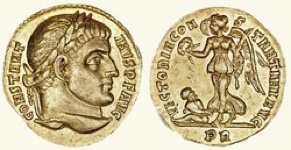
CONSTANTINVS P F AVG/ VICTORIA CONSTANTINI AVG
RIC VI Rome 285a, 312-3 AD
After his victory over the ‘usurper’ Maxentius in Rome in 312 AD, the senate acknowledged Constantine as the most senior member of the ruling college (which also included Maximinus and Licinius).
Cirta
According to Aurelius Victor, shortly after Constantine took Rome in 312 AD:
“... , per Africam (in or throughout Africa), a college of priests was decreed to the gens Flavia: and the city of Cirta, which had been ruined by the siege of Domitius Alexander, was rebuilt, embellished, and re-named Constantina” (“De Caesaribus” 40:28).
The new name is well-documented:
✴Noel Lenski (referenced below, at p. 142 and p. 321, note 72) referred to a document of 320 AD that referred to a decurione Constantiniensium (decurion of the citizens of Constantina).
✴The new name is also recorded in the inscriptions (CIL VIII 7012), LSA-2321 and CIL VIII 7013, LSA-2327) on the bases of two statues of Ceionius Italicus, the governor (consularis) of Numidia, which had been set up in the forum of ‘Constantinae civitatis’ in the period 340-50 AD:
•the first of these was set up by the city council (ordo) of Constantina and the provincial assembly of Numidia; and
•the second was set up by the council of the small city of Milev, ‘at their own request and that of the province’. Ulrich Glen (in his commentary on this inscription in the LSA database - use the link above) commented that:
“Our inscription is a re-use of a base (LSA-2232) first used for a dedication to Constantine I in 313/37 AD. This is a remarkable case of the rapid recycling of a statue base, furthermore of one to a revered emperor, the founder of the dynasty in power... and the 're-founder' of Cirta.”
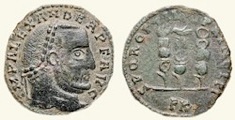

IMP ALEXANDER P F AVG CONSTANTINVS P F AVG
S P Q R OPTIMO PRINCIPI S P Q R OPTIMO PRINCIPI
RIC Carthage 72 RIC Trier 815
The historical context given by Aurelius Victor for the re-naming of Cirta can be summarised as follows: Domitius Alexander, who had been Vicar of the Diocese of Africa under Maxentius, had rebelled against him in ca. 308 AD, seized control of the African provinces and cut off the supply of wheat to Rome. His revolt had ended a year later with a successful siege of the naturally fortified city of Cirta, after which Maxentius had extracted terrible reprisals. (As discussed in my page on Maxentius in Rome (308-11 AD), there is evidence that Constantine might have been involved in Domitius Alexander’s revolt:
✴An inscription (CIL VIII 22183; EDCS-27600228) from Sidi Hamza in the the Province of Africa Proconsularis, commemorated:
L(ucio) Domitio Alexandro et Fl(avio) Constantino, Augg(ustis)”.
✴The coins illustrated above, which were minted (respectively) by Domitius Alexander and Constantine at about this time, suggest that their respective designs on Rome were linked in some way.
After Maxentius’ defeat in 312 AD, Constantine sent them Maxentius’ head to the people of the African provinces, presumably to demonstrate the revenge that he had extracted on their behalf:. He also established the cult of his gens Flavia there, as evidenced by Aurelius Victor (above). As set out in my page on Constantine's Imperial Cult, there is evidence that Cirta was one of the centres of this cult. In short, the rebuilding and renaming of Cirta and the establishment per Africam of the cult of the gens Flavia should probably be seen as part of a programme that stressed Constantine’s role as the liberator of the region.
Portus
Portus is the name of the port at the mouth of the Tiber, which (like nearby Ostia) was crucial for the supply of food from Africa to Rome. It had been dependent upon Ostia until Constantine granted its independence and renamed it as Flavia Constantiniana. The date of these changes is uncertain, but it seems that Portus was independent in 314 AD, when Bishop Gregorius of Portus Romae (rather than Portus Ostiensis) attended the council in Arles.
It is interesting to note that Maxentius had favoured Ostia by (for example) moving the mint there from Carthage in 309 AD. After Constantine defeated Maxentius in 312 AD, he moved the mint again, to Arles (see below). This suggests that Constantine’s honours to Portus had at least two political purposes:
✴by making Portus independent, he further punished Ostia for its support of Maxentius; and
✴by giving the newly-independent city an imperial title, he asserted the legitimacy of his recent elevation to the rank of senior Augustus in dynastic terms.
The earliest surviving reference to “civitas Flavia Constantiniana Portuensis” is in fact quite late: it comes from an inscription (CIL XIV 4449, LSA 1660) from Portus that commemorates Lucius Crepereius Madalianus:
Fide exercitationem/ bonitati pollenti Lucio/ Crepereio Madaliano v(iro) c(larissimo)
praef(ecto) ann(onae) cum iure gladii/ comiti Flaviali, corr(ectori) Flam(iniae)/ et Piceni
leg(ato) pro praetore prov(inciae)/ Asiae, leg(ato) prov(inciae) Africa,
consula(ri)/ aed(ium) sacrar(um), consul(ari) molium fari/ at(que?) purgaturae
quaest(ori) candid(ato), /praet(ori), consuli
Ob multa in se eius/ testimonia, ordo et populus
Fl(aviae) Constantinianae Portuensis
statuam publicae ponendam / censuerunt
This can be translated:
To a man disciplined by faith, powerful in excellence, Lucius Crepereius Madalianus, of clarissimus rank:
-Prefect of the Annona [responsible for the grain supply to Rome] with jurisdiction over capital sentences;
-Flavian comes [member of Constantine’s court;
-Corrector (governor) of the Province of Flaminia and Picenum;
-legate representing the praetor of the province of Asia;
-legate of the province of Africa;
-supervisor of sacred buildings;
-supervisor of the lighthouse and of the maintenance of the port;
-quaestor, praetor, suffect consul.
On account of the many proofs of his affection for it, the council (ordo) and people of Flavia Constantiniana Portuensis decreed that a statue be set up with its own funds.
The inscription is also discussed in more detail in my page on Divus Constantinus.
This does not mean that suggests that Lucius Crepereius Madalianus secured the honour of imperial renaming for Flavia Constantiniana Portuensis (which probably happened ‘before his time’. Nevertheless, he was clearly an important patron of the city in his capacity of Prefect of the Annona, and also an important member of the imperial court. It is therefore logical that Portus would stress the imperial name of their city when honouring Crepereius.
Constantine, Sole Augustus
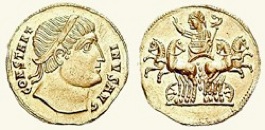
CONSTANTINVS AVG
RIC VII Constantiniple 1 or similar (ca. 324 AD)
After his victory over Licinius in 324 AD, Constantine became the sole Augustus. He presided over a ruling college that also included his three sons as Caesars: Crispus; Constantine junior; and the newly-elevated Constantius.
For a short period after the victory, Crispus ruled in the west fromGaul, with his capital at Trier remained the capital of Gaul. After his execution in 326 AD, Constantine made temporary arrangements for the governance of Gaul. He returned to Trier in 328 AD to address some issues of border security and then left his 12 year old son Constantine junior at Trier as a formal replacement for Crispus. According to Timothy Barnes (referenced below, at p. 84), Constantine junior had his principal residence at Trier until his death in 340 AD.
Arles
The ancient city of Arelate (Arles) was reconstituted by Julius Caesar as Colonia Julia Paterna Arelate Sextanorum in 46 BC for veterans of the 6th Legion. Although it was not a provincial capital, it was one of the most important cities of Gaul. It had been an imperial residence of both Maximian and Constantius I, and Constantine probably resided here from time to time in the period 312-6 AD. Constantine transferred a mint from Ostia to Arles in 313 AD. He held an important Church Council here in 314 AD. Constantine junior (his first son by his second wife, Fausta) was born here in 316 AD. There is evidence that a temple in the forum of ‘Arelatensium civitatem’ was built or at least re-dedicated to honour the imperial family in the period 324-6 AD (as discussed in my page Constantine's Imperial Cult).
After the execution of Crispus in 326 AD, Constantine renamed Arles as Constantina. Noel Lenski (referenced below, at p. 140) quoted an extract from a letter that the city wrote to Pope Leo I in 450 AD, which recorded that:
“The city was especially honoured by Constantine ... [from whom] it received the name Constantina in addition to its own name, which is called Arelas”
Richard Burgess (referenced below, at p. 278) deduced that this occurred in 328 AD:
“While in Gaul in late 328 AD, Constantine renamed Arles in honour of his son Constantine [junior], who had been born there in 316 AD.”
As Burgess pointed out:
✴the date of the name change was indicated by a corresponding change in the the local mint mark, which became “CONST” from that point; and
✴evidence for the assumption that the renaming honoured Constantine junior is provided by the fact that the mint mark “CONST” disappeared in 340 AD, the year in which the younger Constantine (by then the Emperor Constantine II) was killed after a power struggle with his younger brother, the Emperor Constans.
Constantine’s Later Years (333-7 AD)
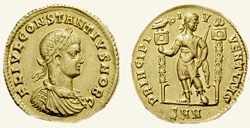
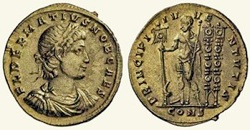
FL CONSTANS NOB CAES L DELMATIVS NOB CAES
CONSTANS NOB CAESAR DELMATIVS CAESAR
RIC VII (Constantinople) 97 (ca. 333AD) RIC VII (Constantinople) 98 (ca. 335AD)
Constantine appointed his third surviving son, the ten year old Constans, as Caesar in 333 AD. The dream articulated for Constantine in Panegyric IV (translated into English in Nixon and Rodgers, referenced below) some two decades earlier comes to mind here:
“... the future will truly be blessed if, when you have installed your sons at the helm of the world, you are the greatest Emperor of all” (26:5)
In 335 AD, Constantine created is nephew, Flavius Dalmatius (or Delmatius) as the fourth Caesar, perhaps in active preparation for his own demise.
Constantine thus left four designated heirs, whom he hoped would continue to rule as a dynastic tetrarchy. The plan did not quite work out: Constantine’s sons conspired to murder their cousin (and most of his close relatives): Richard Burgess (referenced below) has demonstrated that this treacherous deed was carried out in early June. 337 AD. Three months later, in September 337 AD, Constantine’s sons met at Sirmium, where the Danubian army proclaimed them as Augusti:
✴Constantius II, for the Asian provinces and Egypt ;
✴Constantine II, for Gaul, Spain and Britain; and
✴Constans, under Constantine II, for the Italian and African provinces.
The respective territories of the three new Augusti are illustrated in this map (part of the on-line resource published by Ian Mladjov, University of Michigan).
Hispellum, Rescript of Constantine
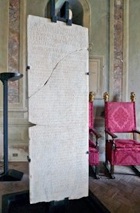
✴Flavius Constantinus [i.e. Constantine junior];
✴Flavius Julius Constantius [i.e. Constantius junior]; and
✴Flavius Constans.
In the Rescript (or more precisely, in the version of the Rescript that is reproduced in the inscription), Constantine replied, broadly in the affirmative, to three requests. Constantine (in the early part of the Rescript) summarised the first of these as follows:
“[You have asked that] we grant to your city, which is now called Hispellum ... a name de nostro cognomine (from our cognomen/ family name) ...”.
His reply was in the affirmative:
“... we have conceded to the city of Hispellum the eternal designation and venerable name from our own appellation”.
(These translations into English are based on that by Noel Lenski (referenced below, pp. 118-9).
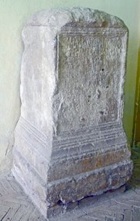
“... the whole urban populace (plebs urbana) of Flavia Constans [set this up] to a most worthy patron
There has been a great deal of argument as to the precise date of the Rescript, which is complicated by the fact that none of Constantine’s sons is identified in the inscription as Caesar. In my page Spello: Rescript of Constantine, I argue in favour of the proposal of Raymond van Dam (referenced below, pp. 53-4), who suggested that their common designation as Caesar had simply been omitted in the inscription, although presumably not in the Rescript itself. Thus, he suggested that the Rescript had been issued after the accession of Constans but before that of Dalmatius: i.e. in the period between December 333 AD and September 335 AD. In any case, whatever their detailed differences, most scholars now accept that the Rescript was issued towards the end of Constantine’s life or during the brief interregnum thereafter.
The case of the renaming of Hispellum is unique in so far as we know from the Rescript a good deal about the circumstances in which the honour was conferred. As mentioned above, the Rescript addressed three requests:
✴Two of these requests apparently related to Hispellum itself:
•that Constantine should give a name derived from his cognomen to the city (as discussed here); and
•that a temple of his Flavian family should be built in the city. This temple was duly built in the sanctuary (remains survive under what is now the church of San Fedele) and Caius Matrinius Aurelius Antoninus presumably presided over it in his capacity of pontifex gentis Flavia.
✴The third request seems to have been made on behalf of the “Umbrians” (presumably a group of Umbrian cities represented by Hispellum):
•The supplicants recorded that they had previously selected a priest to represent them (alongside a similar priest selected by the “Etruscans”) at an annual festival involving theatrical shows and gladiatorial games that had been held at Volsinii, a city of Tuscia (Etruria).
•They requested that, in future, this Umbrian priest should preside over a version of the festival at Hispellum (presumably using the theatre and amphitheatre in the sanctuary), while the traditional practice would continue, otherwise unchanged, at Volsinii.
The detail of the inscription is set out in my page Spello: Rescript of Constantine, I argue that:
✴we can reasonably assume that the annual festival that featured in the third request was dedicated to the cult of Constantine’s gens Flavia; and
✴we should therefore treat the Rescript as the (largely affirmative) answer to what was, in effect, a single request: that a cult site for the gens Flavia should be established at Hispellum and reflected in its new name, Urbs Flavia Constans.
The Rescript was issued at about the time at which Constantine’s plans for the dynastic succession were about to be put to the test. Nowhere was this issue more delicate than in the provinces of Italy and Africa, where power was to pass to the young and untried Constans. The honour afforded to Hispellum (now Flavia Constans) and the revitalisation of the pan-Umbrian sanctuary there were surely part of an associated propaganda programme.
Fano
The present city of Fano stands on the site of the ancient Fanum Fortunae, at the point where the Via Flaminia reached the Adriatic coast. The Emperor Augustus established the Colonia Julia Fanestris here as part of his programme of veteran resettlement. The foundation of the colony is commemorated in an inscription (CIL XI 6218) on the so-called the Arch of Augustus in the city walls, which dates to 10 AD:
Imp(erator) Caesar, Dìvì f(ilius), Augustus, pontifex maximus, co(n)s(ul) XIII, tribunicia potest(ate) XXXII/ imp(erator) XXVI, pater patriae, murum dedit
An imperial rescript of 365 AD recorded the city as Flavia Fanestri, which suggests that it had been renamed as such by Constantine or by one of his sons. The location of the city at the start of Via Flaminia suggests that its renaming might well have been associated with a particular imperial visit. If it was renamed by Constantine himself, there are two obvious times at which this renaming would have been particularly appropriate:
✴in preparation for his brief visit to Rome in 326 AD for his vicennalia (the celebration of his first 20 years in office); or
✴as part of similar preparations ten years later for an expected visit to celebrate his tricennalia, a visit that, as it turned out, did not take place.
Another possibility is that the renaming was broadly contemporary with the insertion on the Arch of Augustus of a second inscription, which reads:
Divo Augusto Pio Constantino patri Dominorum
Curante L(ucio) Turcio Secundo Aproniani praef(ecti) urb(i) fil(io), Asterio
v(iro) c(larissimo), corr(ectore) Flam(iniae) et Piceni
It was associated with a restoration that was commissioned by Lucius Turcius Secundus Apronianus, signo Asterius. The inscription identifies him as:
✴the son of Lucius Turcius Apronianus, the Urban Prefect of 339 AD; and
✴governor of the province of Flaminia et Picenum, a post that he apparently held in the 340s AD.
This inscription, which must postdate 339 AD, most probably dates to the 340s, when Asterius was still the provincial governor. If this coincided with the renaming of Fano, the honour would have been conferred by Constans, the Augustus responsible for the Italian provinces.
The inscription is also discussed in my page on Divus Constantinus.
Conclusions
The context in which Constantine renamed Augustodunum as Flavia Aeduorum (Flavia of the Aedui tribe) are clear:
✴after the demise of Maximian, he was intent upon defining his own Flavian dynasty; and
✴as he contemplated the ejection of Maxentius from Rome, and following his vision at Andesina, he wanted to project himself as a new Augustus, destined to become the sole ruler of the Roman Empire.
The respective territories of the Caesars at the time of the Rescript are illustrated in this map (part of a brilliant on-line resource published by Ian Mladjov, University of Michigan). In the case of Hispellum, the prospective successor in question would have been the young and untried Constans (who seems to have resided in Milan in 335-7 AD, presumably with his succession in mind). These circumstances probably explain why the honour paid to Hispellum in the Rescript was its renaming as Urbs Flavia Constans.
Read more:
N. Lenski, “Constantine and the Cities: Imperial Authority and Civic Politic”, (2016) Pennsylvania
R. L. Testa, “Tolerance for the Gentiles, Intolerance of Heretics: The First Interventions of Constantine in the Life of the Catholic Church and of the Pagan Priests”, in
V. Vachkova and D. Dimitrov (Eds.), “Serdica Edict (311 AD): Concepts and Realizations of Idea of Religious Toleration”, (2014) Sofia pp. 89-108
E. Zuddas, “Osservazioni sui Coronati Tusciae et Umbriae”, Hormos: Ricerche di Storia Antica, 5 (2013)
T. Barnes, “Constantine: Dynasty, Religion and Power in the Later Roman Empire”, (2011) Chichester
M. Heijmans, “Constantina Urbs: Arles durant le IVe Siècle: Une Autre Résidence Impériale ?”, extract from "Konstantin des Grosse: Geschichte; Archäologie ; Rezeption”, (2007) Trier
R. van Dam, “Roman Revolution of Constantine”, (2007) Cambridge
R. Burgess, “Studies in Eusebian and Post-Eusebian Chronography”, (1999) Stuttgart
K. Tabata, “The Date and Setting of the Constantinian Inscription of Hispellum”, Studi Classici e Orientali, 45 (1995) 369-410
B. Saylor Rodgers, “Constantine's Pagan Vision”, Byzantion 50 (1980) 259-78
Constantine: Constantine as Primi Nominis Constantine as Sole Augustus
Constantine and Rome Constantine's Re-naming of Cities
Constantine's Imperial Cult Divus Constantinus
Literary Sources: Diocletian to Constantine (285-337 AD)
Return to the History Index